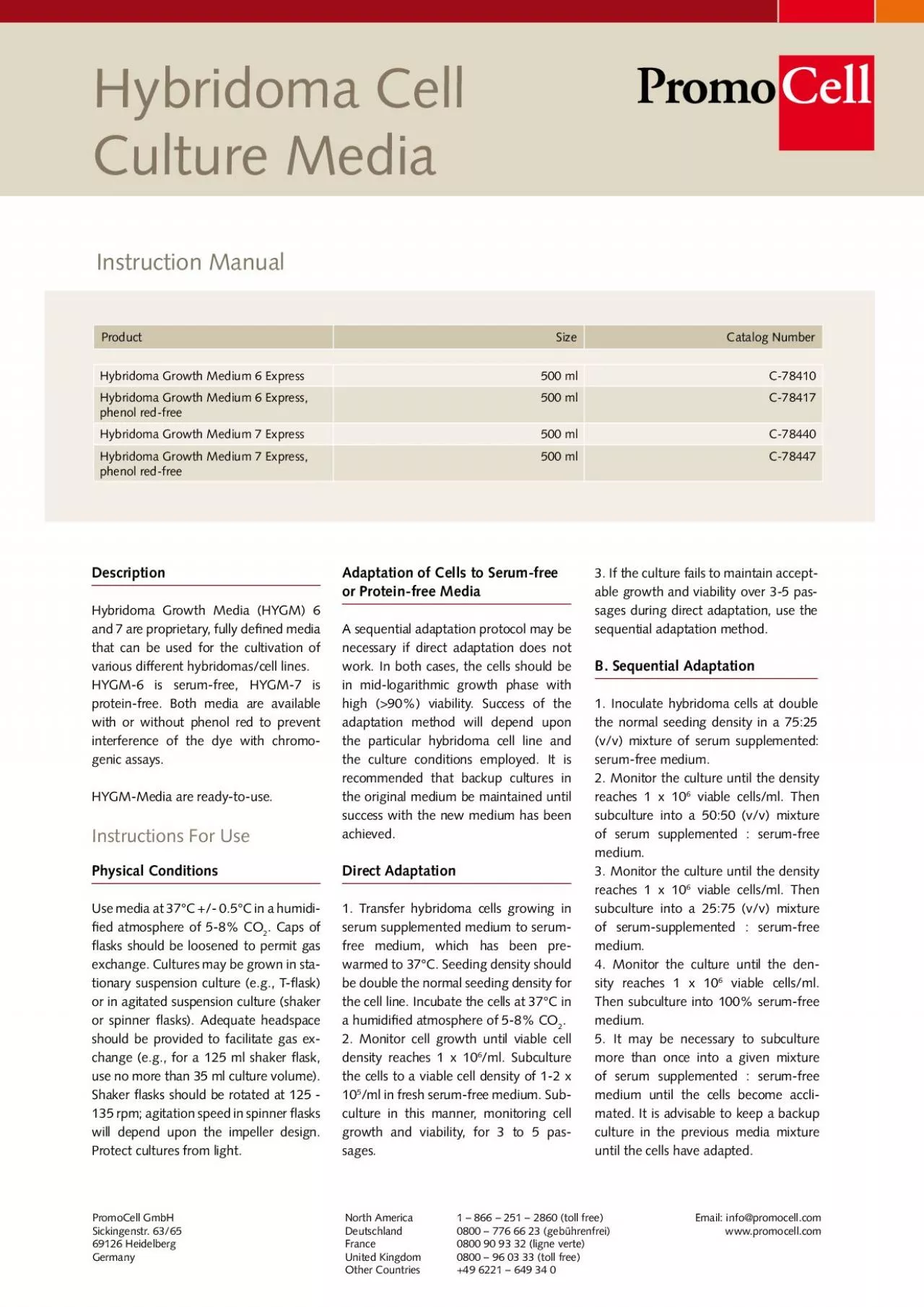

Product 1 150 866 150 251 150 2860 toll free0800 150 776 66 23 gebührenfrei 0800 150 96 03 33 toll freePromoCell GmbHSickingenstr 636569126 HeidelbergEmail infopromocellcom ID: 960796
Download Pdf The PPT/PDF document "Instruction Manual" is the property of its rightful owner. Permission is granted to download and print the materials on this web site for personal, non-commercial use only, and to display it on your personal computer provided you do not modify the materials and that you retain all copyright notices contained in the materials. By downloading content from our website, you accept the terms of this agreement.
Instruction Manual Product 1 – 866 – 251 – 2860 (toll free)0800 – 776 66 23 (gebührenfrei) 0800 – 96 03 33 (toll free)PromoCell GmbHSickingenstr. 63/6569126 HeidelbergEmail: info@promocell.comwww.promocell.comCulture Media Hybridoma Growth Media (HYGM) 6 and 7 are proprietary, fully de ned media that can be used for the cultivation of various different hybridomas/cell lines. HYGM-6 is serum-free, HYGM-7 is A sequential adaptation protocol may be necessary if direct adaptation does not work. In both cases, the cells should be 3. If the culture fails to maintain acceptable growth and viability over 3-5 pas Serum-free, Serum-free, Protein-free, Protein-free, Protein contentAddition requiredNone, ready-to-useNone, ready-to-useNone, ready-to-useNone, ready-to-use HYGM-6 ExpressHYGM-6 ExpressHYGM-7 ExpressHYGM-7 Express Hybridoma Cell Culture Media2 1. Prepare desired quantity of cells, harvesting in mid-log phase of growth with2. Determine the viable cell density and calculate the required volume of cryopreservation medium (50% fresh medium : 50% conditioned medium + DMSO to a nal concentration of 7.5%) to give a nal cell density of 0.5 - 1.0 x 10 cells/ml. Conditioned medium should be obtained from a high viability, mid-log culture of cells.3. Prepare the required volume of cryopreservation medium and hold the medium at 4°C until use (make cryopreser4. Pellet the cells from culture medium at 100 x g for 5 minutes. Resuspend the pellet in the pre-determined volume of 4°C cryopreservation medium.5. Disp
ense aliquots of this suspension into cryovials according to the manufacturer’s speci cations.6. Achieve cryopreservation in either an automated or manual controlled rate freezing apparatus following standard procedures (1°C decrease per minute).7. Frozen cells are stable inde nitely under liquid nitrogen. 1. Recover cultures from frozen storage by rapid thawing of a vial of cells in a 37 °C water bath with shaking just until 2. Transfer the entire contents of the vial into the appropriately sized vessel so that the cells are seeded at 5 x 10cells/ml of complete growth medium.3. Incubate the culture in a humidi ed atmosphere of 5-8% CO at Do not centrifuge the cells as they are extremely fragile upon recovery from cryopreservation.4. Maintain the culture between 5 x and 10 x 10 viable cells/ml for the rst two subcultures following recovery; thereafter, return to the normal mainteStore the Medium at 4 to 8°C in the dark immediately after arrival. Do not freeze. If stored properly, the product is stable All lots of PromoCell speciality cell culture media are subjected to comprehensive quality control tests. Each lot is routinely tested for growth promotion, absence of cytotoxicity, and physical parameters such as osmolality and pH level. Approved in-house lots of media are used as a reference.In addition, all lots of media have been tested for the absence of microbial conThe products are for in vitro research use only and not for diagnostic or therapeutic procedures. For safety precautions please see appropriate MSDS